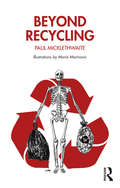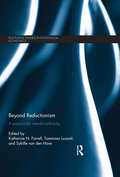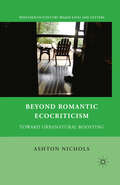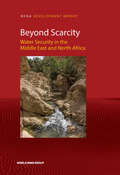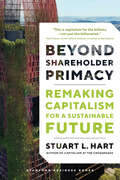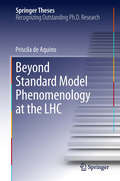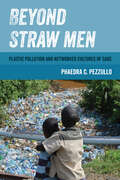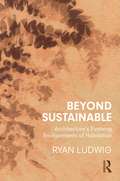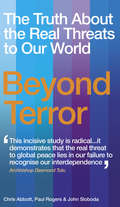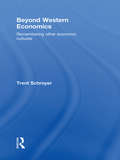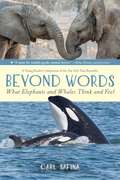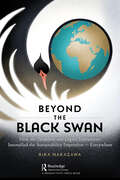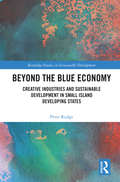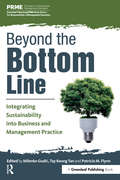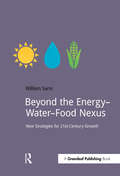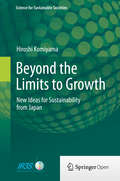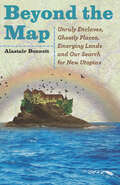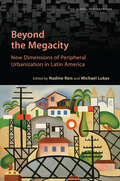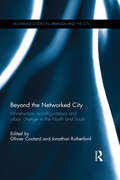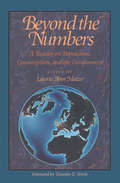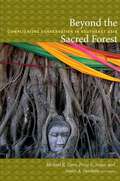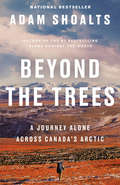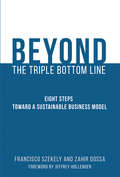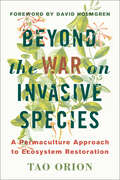- Table View
- List View
Beyond Recycling
by Paul MicklethwaiteBeyond Recycling critically explores unasked questions around recycling and its prominent position in contemporary thinking about sustainability. It examines and challenges assumptions about why we appear to have so wholeheartedly committed to recycling as a cultural project. Recycling has become a commonplace notion and widespread practice. Yet its social, cultural and even environmental value has not been considered carefully enough. This book considers recycling as a contemporary cultural idea related to – but not wholly defied by – our response to material waste. It seeks to reclaim recycling from the environmentalists and waste management specialists, to explore the role it plays in wider contemporary discourse. As we become increasingly satiated, and in many cases sickened, by the excesses of modern consumerism, we are rethinking our relationship with the physical stuff that fills our lives. Dissatisfied with empty materialism, we seek new ways to reuse our material culture. Recycling, turning something considered to be waste into something with renewed value, is our primary collective response to the problems arising from consumption; and it is ripe for critical examination. Beyond Recycling is a fascinating read for conscious consumers and students in the creative arts, design, cultural studies, sustainability and environmental studies.
Beyond Reductionism: A Passion for Interdisciplinarity (Routledge Studies in Ecological Economics #24)
by Katharine N. Farrell Tommaso Luzzati Sybille van den HoveThis is a book about the work of scientists in the era of the Anthropocene: where human beings appear to have become a driving force in the evolution of the planet. It is a diverse collection of empirical, methodological and theoretical chapters concerned with the practice of interdisciplinary social-ecological systems research. The aim of the contributors is to give the reader an appreciation for the range and complexity of the challenges faced by researchers, research institutions and wider communities trying to make sense of the causes and consequences of the this new era of global environmental change. The tragedy of the Anthropocene, of the large scale anthropogenic habitat destruction and planet-wide impacts of anthropogenic climate change, is not that science has failed humanity but rather that it has served humanity all too well, making possible in just a few hundred years volumes and scales of human activity far exceeding anything ever seen before. Coming to terms with that success was the aim of the 1969 Alpbach Symposium, from which this book draws its name, where contributors including Friedrich Hayek and Ludwig von Bertalanffy, asked themselves: what theory, practices and standards are required to move beyond reductionism? Like those from 1969, the answers presented in this collection are hugely diverse, ranging from PhD students concerned with research methods and institutional obstacles, to mid-career scholars presenting their innovative ‘beyond-reductionism’ research methods, to emeritus professors looking back over what has been achieved in the past 30 years and suggesting where things might go from here. All the contributors begin from the premise that the challenges of the Anthropocene can only be successfully met if interdisciplinary research effectively brings together social and natural sciences, the humanities, stakeholders and decision makers. They conclude, in unison, that both the institutional and the methodological foundations needed to do this work are still sorely lacking. While this may seem a dismal position, the book is full of success stories, such as: the integrative approach of MuSIASEM (Multi-Scale Integrative Assessment of Social-Ecological Metabolism) developed by Mario Giampietro’s group in Barcelona, Spain; the alternative perspectives of what Ariel Salleh calls the ‘meta-industrial’ discourse in Ecofeminism; or the innovative trans-departmental status of the Stockholm Resilience Centre in Sweden. Putting both the theoretical and methodological challenges of moving beyond reductionism on the table for discussion, this text aims to help a growing community of passionate thinkers and actors better understand themselves and their work.
Beyond Romantic Ecocriticism: Toward Urbanatural Roosting (Nineteenth-Century Major Lives and Letters)
by Ashton NicholsNichols chronicles the Enlightenment view of 'Nature' as static and separate from humans as it moved towards the Romantic 'nature' characterized by dynamic links among all living things. Engaging Romantic and Victorian thinkers, as well as contemporary scholarship, he draws new conclusions about 21st-century ideas of nature.
Beyond Scarcity: Water Security in the Middle East and North Africa
by World BankWater has always been a source of risks and opportunities in the Middle East and North Africa. Yet rapidly changing socioeconomic, political, and environmental conditions make water security a different, and more urgent, challenge than ever before. This report shows that achieving water security means much more than coping with water scarcity. It means managing water resources in a sustainable, efficient, and equitable way. It also involves delivering water services reliably and affordably, to reinforce relationships between service providers and water users and contribute to a renewed social contract. Water security also entails mitigating water-related risks such as floods and droughts. Water security is an urgent target, but it is also a target within reach. A host of potential solutions to the region’s water management challenges exist. To make these solutions work, clear incentives are needed to change the way water is managed, conserved, and allocated. To make these solutions work, countries in the region will also need to better engage water users, civil society, and youth. The failure of policies to address water challenges can have severe impacts on people’s well-being and political stability. The strategic question for the region is whether countries will act with foresight and resolve to strengthen water security, or whether they will wait to react to the inevitable disruptions of water crises.
Beyond Shareholder Primacy: Remaking Capitalism for a Sustainable Future
by Stuart HartFrom the author of Capitalism at the Crossroads, a call to consciousness—and action—for individuals, organizations, communities, and nations. Our current Milton Friedman–style "shareholder primacy capitalism," as taught in business schools and embraced around the world, has become dangerous for society, the climate, and the planet. Moreover, Stuart L. Hart argues, it's economically unnecessary. But there are surprising reasons for hope—from the history of capitalism itself. Beyond Shareholder Primacy argues that capitalism has reformed itself twice before and is poised for a third major reformation. Retelling the origin story of capitalism from the fifteenth century to the present, Hart argues that a radically sustainable, just capitalism is possible, and even likely, in our lifetime. Hart goes on to describe what it will take to move beyond capitalism's present worship of "shareholder primacy," including corporate transformations to re-embed purpose and reforms to major economic institutions. A key requirement is eliminating the "externalities" (or collateral damage) of our current shareholder capitalism. Sustainable capitalism will explicitly incorporate the needs of society and the planet, include a financial system that allows leaders to prioritize the planet, reorganize business schools around sustainable management thinking, and enable corporations not just to stop ignoring the damage they cause, but actually begin to create positive impact.
Beyond Smoke and Mirrors
by Burton RichterGlobal climate change is one of the most important issues humanity faces today. This book assesses the sensible, senseless and biased proposals for averting the potentially disastrous consequences of global warming, allowing the reader to draw their own conclusions on switching to more sustainable energy provision. Burton Richter is a Nobel Prize-winning scientist who has served on many US and international review committees on climate change and energy issues. He provides a concise overview of our knowledge and uncertainties within climate change science, discusses current energy demand and supply patterns, and the energy options available to cut emissions of greenhouse gases. Written in non-technical language, this book presents a balanced view of options for moving from our heavy reliance on fossil fuels into a much more sustainable energy system, and is accessible to a wide range of readers without scientific backgrounds - students, policymakers, and the concerned citizen.
Beyond Standard Model Phenomenology at the LHC (Springer Theses)
by Priscila De AquinoThis thesis provides an introduction to the physics of the Standard Model and beyond, and to the methods used to analyse Large Hadron Collider (LHC) data. The 'hierarchy problem', astrophysical data and experiments on neutrinos indicate that new physics can be expected at the now accessible TeV scale. This work investigates extensions of the Standard Model with gravitons and gravitinos (in the context of supergravity). The production of these particles in association with jets is studied as one of the most promising avenues for researching new physics at the LHC. Advanced simulation techniques and tools, such as algorithms allowing the computation of Feynman graphs and helicity amplitudes are first developed and then employed.
Beyond Straw Men: Plastic Pollution and Networked Cultures of Care (Environmental Communication, Power, and Culture #4)
by Phaedra C. PezzulloAddressing plastics can feel overwhelming. Guilt, shame, anger, hurt, fear, dismissiveness, and despair abound. Beyond Straw Men moves beyond "hot take" or straw man fallacies by illustrating how affective counterpublics mobilized around plastics reveal broader stories about environmental justice and social change. Inspired by on- and offline organizing in the Global South and the Global South of the North, Phaedra C. Pezzullo engages public controversies and policies through analysis of hashtag activism, campaign materials, and podcast interviews with headline-making advocates in Bangladesh, Kenya, the United States, and Vietnam. She argues that plastics have become an articulator of crisis and an entry point into the contested environmental politics of carbon-heavy masculinity, carceral policies, planetary fatalism, eco-ableism, greenwashing, marine life endangerment, pollution colonialism, and waste imperialism. Attuned to plastic attachments, Beyond Straw Men illustrates how everyday people resist unsustainable patterns of the plastics-industrial complex through imperfect but impactful networked cultures of care.
Beyond Sustainable: Architecture's Evolving Environments of Habitation
by Ryan LudwigBeyond Sustainable discusses the relationship between human-beings and the constructed environments of habitation we create living in the Anthropocene, an increasingly volatile and unpredictable landscape of certain change. This volume accepts that human-beings have reached a moment beyond climatological and ecological crisis. It asks not how we resolve the crisis but, rather, how we can cope with, or adapt to, the irreversible changes in the earth-system by rethinking how we choose to inhabit the world-ecology. Through an examination of numerous historical and contemporary projects of architecture and art, as well as observations in philosophy, ecology, evolutionary biology, genetics, neurobiology and psychology, this book reimagines architecture capable of influencing and impacting who we are, how we live, what we feel and even how we evolve. Beyond Sustainable provides students and academics with a single comprehensive overview of this architectural reconceptualization, which is grounded in an ecologically inclusive and co-productive understanding of architecture.
Beyond Terror: The Truth About the Real Threats to Our World
by Paul Rogers Chris Abbott John SlobodaIs international terrorism really the single greatest threat to world security?Since the 9/11 attacks, many Western governments assume terrorism to be the greatest threat we face. In response, their dangerous policies attempt to maintain control and keep the status quo by using overwhelming military force. This important book shows why this approach has been such a failure, and how it distracts us from other, much greater, threats of climate change, competition over resources, marginalisation of the majority of the world and global militarisation.Unless urgent, coordinated action is taken in the next 5-10 years on all these issues it will be almost imossible to avoid the earth becoming a highly unstable place by the middle years of this century. Beyond Terror offers an alternative path for politicians, journalists and concerned citizens alike.
Beyond Western Economics: Remembering Other Economic Cultures
by Trent SchroyerThis book combines intellectual history with contemporary events to offer a critique of mainstream economic thought and its neoliberal policy incarnation in global capitalism. The critique operates both theoretically, at the level of metaphysics and the philosophy of science, and concretely, in case studies of globalization and world events. Trent Schroyer provides a moral and cultural interpretation of modernity and scientism, highlighting their political and economic consequences – but the book’s main purpose is not to criticize. The author moves beyond this to offer alternative "economic cultures," again combining abstract theoretical analysis with concrete case studies of alternative economic formations from local self-sufficiency movements to cooperatives and other anti-capitalist institutional experiments. These case studies exhibit an impressive range of variation, from first world to third world, from reformist to utopian transformative. Finally, Schroyer links the project to the global justice movement that opposes corporate globalization and eventually links participatory economics and democratic politics to a new image of science as "participatory social learning."
Beyond Words: What Animals Think And Feel (Beyond Words #1)
by Carl SafinaA young reader’s adaptation of The New York Times bestsellerFollow researcher Carl Safina as he treks with a herd of elephants across the Kenyan landscape, then travel with him to the Pacific Northwest to track and monitor whales in their ocean home. Along the way, find out more about the interior lives of these giants of land and sea—how they play, how they fight, and how they communicate with one another, and sometimes with us, too.Weaving decades of field research with exciting new discoveries about the brain and featuring astonishing photographs taken by the author, Beyond Words: What Elephants and Whales Think and Feel gives readers an intimate and extraordinary look at what makes these animals different from us, but more important, what makes us all similar.
Beyond the Black Swan: How the Pandemic and Digital Innovations Intensified the Sustainability Imperative – Everywhere
by Rika NakazawaOf course, anyone would want to wake up from a really bad dream - especially one that seemed like it may never end, while successively stripping away joys and conveniences of our modern living. The COVID-19 pandemic bestowed on us a collective nightmare experience of varying intensity, akin to a "Black Swan" event, as author and mathematical philosopher Nassim Taleb might describe—given its universal rarity and devastating effects and seeming predictability in hindsight. However, we may remember this remarkable time in our history rather as a "White Swan" event—one that catalyzed a more common occurrence of evolving Environmental, Social, and Governance (ESG) principles, a mainstreaming of sustainability—fueled by the digital innovations that designed ways to survive and thrive into a new, and more holistic, world order. Now, as we emerge from the remnants of the pandemic’s aftermath, we find ourselves at the late dawn of a new geologic epoch—the "Anthropocene"—where the impact of humans on the planet’s geology and ecosystems looms so monumentally that the gravest threat to our existence stems from our own actions. Contained within these pages, you will discover insights from leaders across diverse domains—community, industry, public administration, and the investment community. Through their own experiences, we unfurl "White Swan sightings"— moments when sustainability flourished in response to reverberations of the COVID-19 virus. More poignantly, the journey ahead carries us beyond the realm of the Black Swan, while the acceleration of digital innovations equips us to herald a new era out of the Anthropocene and into a new one, with sustainability innovations as a critical placemat. The humanistic seismic shifts caused by the Pandemic will generate a future of holistic interoperability between digital and organic matters. We are on the brink of designing unprecedented harmony with each other and equilibrium of regenerative growth with the world around us. The urgency has never been greater, nor the possibilities so profound.
Beyond the Blue Economy: Creative Industries and Sustainable Development in Small Island Developing States (Routledge Studies in Sustainable Development)
by Peter RudgeThis book argues for a broader approach to sustainable growth in Small Island Developing States (SIDS). Small island states such as those in the Caribbean, Indian Ocean and South Pacific face significant and growing threats from climate change, increasing political and social volatility, and rapidly evolving global trends in technology and tourism. Based on ten years of research, this book looks beyond the Blue Economy of tourism and fisheries and provides a model of how creative industries, innovation networks, creative clusters and digital transformation can give SIDS the foundation for a strong sustainable future. The book provides not only insights into how these emerging digital-creative sectors can drive developing economies but also actionable tools for policy makers, entrepreneurs and academics to deliver increased performance on the United Nations Sustainable Development Goals and, ultimately, growth and sustainability. This book will be of great interest to scholars and practitioners of economic geography, sustainable development, development studies and the creative industries.
Beyond the Bottom Line: Integrating Sustainability into Business and Management Practice
by Patricia M. Flynn Tay Keong Tan Milenko GudićBeyond the Bottom Line: Integrating the UN Global Compact into Management Practice is the first book to look at how the Ten UN Global Compact Principles and the sustainability agenda can be incorporated into business practice. The UN Global Compact is the largest corporate sustainability initiative and, with over 12,000 participating organizations, provides a major influence on global business sustainability practices. Its mission is to guide organizations in how to (1) do business responsibly by aligning their strategies and operations with Ten Principles on human rights, labour, environment and anti-corruption; and (2) take strategic actions to advance broader societal goals, such as the UN Sustainable Development Goals, with an emphasis on collaboration and innovation.This new book addresses head-on some of the most persistent managerial challenges faced by businesses and organizations today. To what extent are businesses able to practice responsible management with regard to the Ten Principles of the UN Global Compact? How can managers of organizations comprehensively and pragmatically address the risks and responsibilities concerning these complex and changing issues in their policies and practice? It also offers a platform for academics to confront some of the most intriguing intellectual challenges on this topic.
Beyond the Energy–Water–Food Nexus: New Strategies for 21st-Century Growth (Doshorts Ser.)
by Will SarniProviding food, clean water and energy for a growing population is one of the greatest challenges facing public and private sector professionals. While there is widespread recognition of the complex feedback loops between energy, water and food, there has been less focus on viable solutions. This guide by Will Sarni – an internationally recognized thought leader on corporate water stewardship and water tech innovation – frames the key issues and challenges for business professionals, and then outlines emerging solutions which include both "soft path" and technology innovation approaches. The book includes case examples of multinational companies who are abandoning business as usual and moving beyond traditional thinking. It also highlights crucial new partnerships or "collective action initiatives" where NGOs, multinationals and the public sector come together to forge practical solutions to meet the needs of their stakeholders. Solutions to the energy–water–food nexus will need to be disruptive, not incremental, and will require technology innovation, new public–private partnerships, and changes in public policy. Beyond the Energy–Food–Water Nexus shows organizations how they can play their part in improving the quality of life for an urbanized global population while preserving the ecosystems that sustain us all.
Beyond the Limits to Growth: New Ideas for Sustainability from Japan (Science for Sustainable Societies)
by Hiroshi KomiyamaAt a time when contemporary challenges seem to many to be insurmountable, this book offers an optimistic view of the future and provides a road map for societies to get there. Drawing upon extensive research and many years as a thought leader in environmental and sustainability issues in Japan and internationally, Hiroshi Komiyama analyzes the most pressing challenges to the attainment of sustainability of economically advanced nations and argues forcefully for Japan to lead them out of the present dilemma through active promotion of creative consumer and societal demand. He shows how an active industry-government-academic partnership can provide the environment needed to promote such new creative demand and illustrates its potential through presentation of a Platinum Society Network that was launched on a regional basis in Japan in 2010 to facilitate the solution of common issues through the exchange of information and ideas. What is perhaps most surprising about the text is its unwavering optimism supported by hard evidence, history, and insightful observation. Problems arising from new paradigms of the 21st century (what the author refers to as "exploding knowledge, limited Earth resources, and aging societies") thwart sustainable development in advanced and developing countries alike. All countries will struggle with issues that evolve from these paradigms including diminishing resources, expanding budget deficits, and growing global environmental problems. This window on potential practical pathways and solutions should be of interest to all those engaged in seeking ways to meet these contemporary challenges.
Beyond the Map: Unruly Enclaves, Ghostly Places, Emerging Lands and Our Search for New Utopias
by Alastair BonnettNew islands are under construction or emerging because of climate change. Eccentric enclaves and fantastic utopian experiments are multiplying. Once-secret fantasy gardens are cracking open their doors to outsiders. Our world is becoming stranger by the day—and Alastair Bonnett observes and captures every fascinating change. In Beyond the Map, Bonnett presents stories of the world’s most extraordinary spaces—many unmarked on any official map—all of which challenge our assumptions about what we know—or think we know—about our world. As cultural, religious and political boundaries ebb and flow with each passing day, traditional maps unravel and fragment. With the same adventurous spirit he effused in the acclaimed Unruly Places, Bonnett takes us to thirty-nine incredible spots around the globe to explore these changing boundaries and stimulate our geographical imagination. Some are tied to disruptive contemporary political turbulence, such as the rise of ISIL, Russia’s incursions into Ukraine and the Brexit vote in the United Kingdom. Others explore the secret places not shown on Google Earth or reflect fast-changing landscapes. Beyond the Map journeys out into a world of mysterious, daunting and magical spaces. It is a world of hidden cultures and ghostly memories, of uncountable new islands and curious stabs at paradise. From the phantom tunnels of the Tokyo subway to a stunning movie-set re-creation of 1950s-era Moscow; from the caliphate of the Islamic State to virtual cybertopias—this book serves as an imaginative guide to the farthest fringes of geography.
Beyond the Megacity: New Dimensions of Peripheral Urbanization in Latin America (Global Suburbanisms)
by Nadine Reis Michael LukasBeyond the Megacity connects and reconnects the global debate on the contemporary urban condition to the Latin American tradition of seeing, considering, and theorizing urbanization from the margins. It develops the approach of "peripheral urbanization" as a way to integrate the theoretical agendas belonging to global suburbanisms, neo-Marxist accounts of planetary urbanization, and postcolonial urban studies, and to move urban theory closer to the complexity and diversity of urbanization in the Global South. From an interdisciplinary perspective, Beyond the Megacity investigates the natures, causes, implications, and politics of current urbanization processes in Latin America. The book draws on case studies from various countries across the region, covering theoretical and disciplinary approaches from the fields of geography, anthropology, sociology, urban studies, agrarian studies, and urban and regional planning, and is written by academics, journalists, practitioners, and scholar-activists. Beyond the Megacity unites these unique perspectives by shifting attention to the places, processes, practices, and bodies of knowledge that have often been neglected in the past.
Beyond the Networked City: Infrastructure reconfigurations and urban change in the North and South (Routledge Studies in Urbanism and the City)
by Jonathan Rutherford Olivier CoutardCities around the world are undergoing profound changes. In this global era, we live in a world of rising knowledge economies, digital technologies, and awareness of environmental issues. The so-called "modern infrastructural ideal" of spatially and socially ubiquitous centrally-governed infrastructures providing exclusive, homogeneous services over extensive areas, has been the standard of reference for the provision of basic essential services, such as water and energy supply. This book argues that, after decades of undisputed domination, this ideal is being increasingly questioned and that the network ideology that supports it may be waning. In order to begin exploring the highly diverse, fluid and unstable landscapes emerging beyond the networked city, this book identifies dynamics through which a ‘break’ with previous configurations has been operated, and new brittle zones of socio-technical controversy through which urban infrastructure (and its wider meaning) are being negotiated and fought over. It uncovers, across a diverse set of urban contexts, new ways in which processes of urbanization and infrastructure production are being combined with crucial sociopolitical implications: through shifting political economies of infrastructure which rework resource distribution and value creation; through new infrastructural spaces and territorialities which rebundle socio-technical systems for particular interests and claims; and through changing offsets between individual and collective appropriation, experience and mobilization of infrastructure. With contributions from leading authorities in the field and drawing on theoretical advances and original empirical material, this book is a major contribution to an ongoing infrastructural turn in urban studies, and will be of interest to all those concerned by the diverse forms and contested outcomes of contemporary urban change across North and South.
Beyond the Numbers: A Reader on Population, Consumption and the Environment
by Judy Norsigian Sharon Stanton Russell G. Rathjens J. Boutwell Adrienne Germain David E. HorlacherBeyond the Numbers presents a thought-provoking series of essays by leading authorities on issues of population and consumption. The essays both define the poles of debate and explore common ground beyond the polarized rhetoric.Specific chapters consider each of the broad topics addressed at the International Conference on Population and Development held in September 1994 in Cairo, Egypt. The essays are supplemented by sidebars and short articles featuring more-impassioned voices that highlight issues of interest not fully explored in the overviews.As well as providing a sense of the difficulties involved in dealing with these issues, the essays make clear that constructive action is possible.Topics covered include: the interrelationships between population, economic growth, consumption, and development the history of population and family planning efforts gender equality and the empowerment of women reproductive rights, reproductive health, family planning, health and mortality
Beyond the Sacred Forest: Complicating Conservation in Southeast Asia
by Michael R. Dove Percy E. Sajise Amity A. DoolittleReflecting new thinking about conservation in Southeast Asia, Beyond the Sacred Forest is the product of a unique, decade-long, interdisciplinary collaboration involving research in Indonesia, Malaysia, and the Philippines. Scholars from these countries and the United States rethink the translation of environmental concepts between East and West, particularly ideas of nature and culture; the meaning of conservation; and the ways that conservation policy is applied and transformed in the everyday landscapes of Southeast Asia. The contributors focus more on folk, community, and vernacular conservation discourses than on those of formal institutions and the state. They reject the notion that conservation only takes place in bounded, static, otherworldly spaces such as protected areas or sacred forests. Thick with ethnographic detail, their essays move beyond the forest to agriculture and other land uses, leave behind orthodox notions of the sacred, discard outdated ideas of environmental harmony and stasis, and reject views of the environment that seek to avoid or escape politics. Natural-resource managers and policymakers who work with this more complicated vision of nature and culture are likely to enjoy more enduring success than those who simply seek to remove the influence and impact of humans from conserved landscapes. As many of the essays suggest, this requires the ability to manage contradictions, to relinquish orthodox ideas of what conservation looks like, and to practice continuously adaptive management techniques. Contributors. Upik Djalins, Amity A. Doolittle, Michael R. Dove, Levita Duhaylungsod, Emily E. Harwell, Jeyamalar Kathirithamby-Wells, Lye Tuck-Po, Percy E. Sajise, Endah Sulistyawati, Yunita T. Winarto
Beyond the Trees: A Journey Alone Across Canada's Arctic
by Adam ShoaltsA thrilling odyssey through an unforgiving landscape, from "Canada's greatest living explorer."In the spring of 2017, Adam Shoalts, bestselling author and adventurer, set off on an unprecedented solo journey across North America's greatest wilderness. A place where, in our increasingly interconnected, digital world, it's still possible to wander for months without crossing a single road, or even see another human being. Between his starting point in Eagle Plains, Yukon Territory, to his destination in Baker Lake, Nunavut, lies a maze of obstacles: shifting ice floes, swollen rivers, fog-bound lakes, and gale-force storms. And Shoalts must time his departure by the breakup of the spring ice, then sprint across nearly 4,000 kilometers of rugged, wild terrain to arrive before winter closes in. He travels alone up raging rivers that only the most expert white-water canoeists dare travel even downstream. He must portage across fields of jagged rocks that stretch to the horizon, and navigate labyrinths of swamps, tormented by clouds of mosquitoes every step of the way. And the race against the calendar means that he cannot afford the luxuries of rest, or of making mistakes. Shoalts must trek tirelessly, well into the endless Arctic summer nights, at times not even pausing to eat. But his reward is the adventure of a lifetime.Heart-stopping, wonder-filled, and attentive to the majesty of the natural world, Beyond the Trees captures the ache for adventure that afflicts us all.
Beyond the Triple Bottom Line: Eight Steps toward a Sustainable Business Model (The\mit Press Ser.)
by Francisco Szekely Zahir DossaA pragmatic new business model for sustainability that outlines eight steps that range from exploring a mission to promoting innovation; with case studies.Many recent books make the case for businesses to become more sustainable, but few explain the specifics. In this book, Francisco Szekely and Zahir Dossa offer a pragmatic new business model for sustainability that extends beyond the traditional framework of the triple bottom line, describing eight steps that range from exploring a vision and establishing a strategy to implementing the strategy and promoting innovation.Szekely and Dossa argue that businesses and organizations need to move away from the business case for sustainability toward a sustainable business model. That is, businesses should go beyond the usual short-term focus on minimizing harm while maximizing profits. Instead, businesses on the path to sustainability should, from the start, focus on addressing a societal need and view profitability not as an end but as a means to support the sustainable organization.Szekely and Dossa explore key problems organizations face when pursuing a sustainability agenda. Each chapter presents one of the eight steps, describes a business dilemma for sustainability, provides a theoretically grounded strategic framework, offers case studies that illustrate the dilemma, and summarizes key findings; the case studies draw on the experiences of such companies as Tesla Motors, Patagonia, TOMs, and Panera. The book emphasizes leadership, arguing that leaders who question the status quo, inspire others, and take risks are essential for achieving sustainable business practices.
Beyond the War on Invasive Species: A Permaculture Approach to Ecosystem Restoration
by Tao OrionInvasive species are everywhere, from forests and prairies to mountaintops and river mouths. Their rampant nature and sheer numbers appear to overtake fragile native species and forever change the ecosystems that they depend on.Concerns that invasive species represent significant threats to global biodiversity and ecological integrity permeate conversations from schoolrooms to board rooms, and concerned citizens grapple with how to rapidly and efficiently manage their populations. These worries have culminated in an ongoing &“war on invasive species,&” where the arsenal is stocked with bulldozers, chainsaws, and herbicides put to the task of their immediate eradication. In Hawaii, mangrove trees (Avicennia spp.) are sprayed with glyphosate and left to decompose on the sandy shorelines where they grow, and in Washington, helicopters apply the herbicide Imazapyr to smooth cordgrass (Spartina alterniflora) growing in estuaries. The &“war on invasive species&” is in full swing, but given the scope of such potentially dangerous and ecologically degrading eradication practices, it is necessary to question the very nature of the battle. Beyond the War on Invasive Species offers a much-needed alternative perspective on invasive species and the best practices for their management based on a holistic, permaculture-inspired framework. Utilizing the latest research and thinking on the changing nature of ecological systems, Beyond the War on Invasive Species closely examines the factors that are largely missing from the common conceptions of invasive species, including how the colliding effects of climate change, habitat destruction, and changes in land use and management contribute to their proliferation.There is more to the story of invasive species than is commonly conceived, and Beyond the War on Invasive Species offers ways of understanding their presence and ecosystem effects in order to make more ecologically responsible choices in land restoration and biodiversity conservation that address the root of the invasion phenomenon. The choices we make on a daily basis—the ways we procure food, shelter, water, medicine, and transportation—are the major drivers of contemporary changes in ecosystem structure and function; therefore, deep and long-lasting ecological restoration outcomes will come not just from eliminating invasive species, but through conscientious redesign of these production systems.&“Beyond the War on Invasive Species is a devastating exposé of the military industrial invasive species complex and a sorely needed and impeccably researched volume that should become one of many as we recover from self-destructive attempts to eradicate parts of nature instead of acting with an understanding of the whole.&”—Ben Falk, author of The Resilient Farm and Homestead and founder of Whole Systems Design
